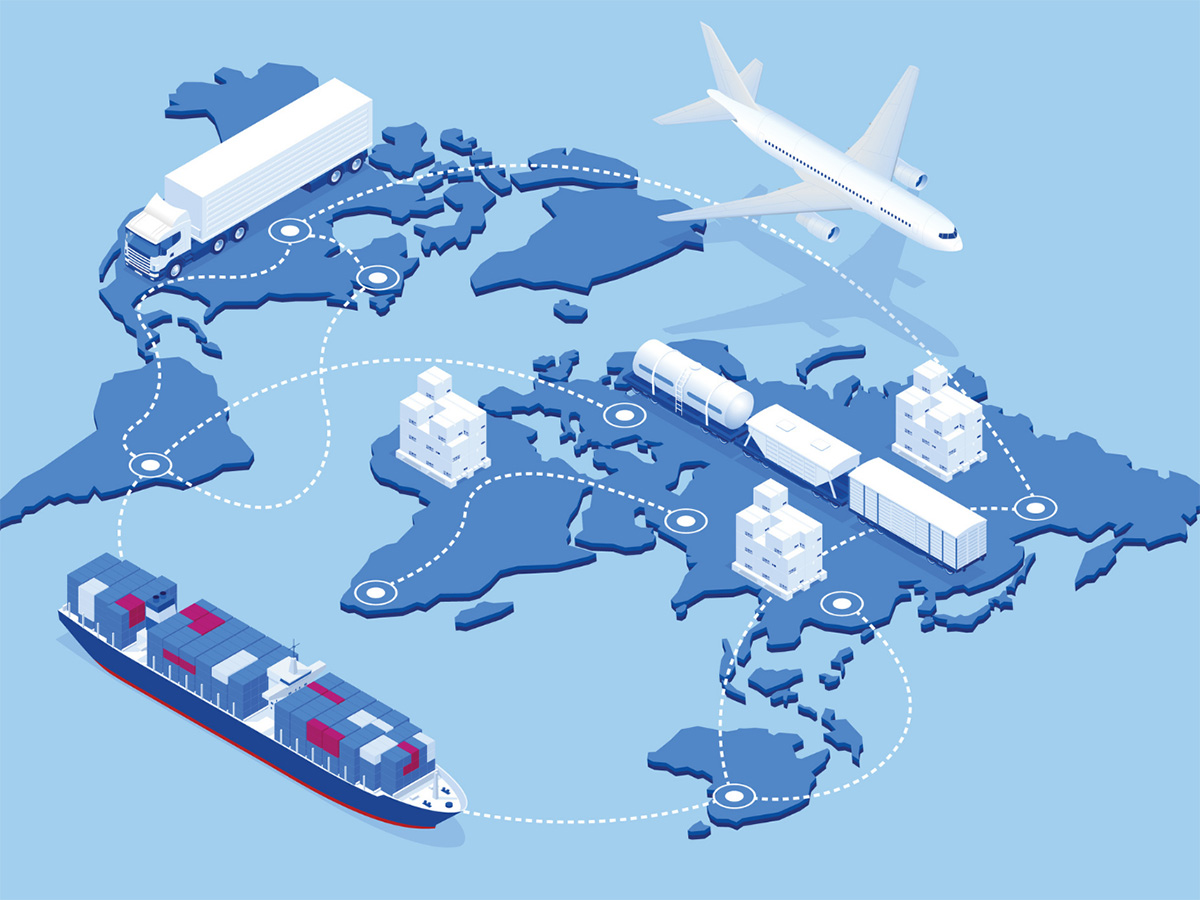

Finance
What Is The Fill Rate Supply Chain?
Published: October 19, 2023
Discover what the fill rate supply chain is and how it impacts finance. Explore strategies to optimize operations and improve financial performance.
(Many of the links in this article redirect to a specific reviewed product. Your purchase of these products through affiliate links helps to generate commission for LiveWell, at no extra cost. Learn more)
Table of Contents
Introduction
Welcome to the world of supply chain management, where efficiency and effectiveness are crucial for success. In today’s competitive market, companies strive to optimize their supply chains to meet customer demands and maximize profitability. One important aspect of supply chain management is the fill rate, which plays a critical role in ensuring customer satisfaction and operational excellence.
The fill rate is a key performance indicator that measures the percentage of customer orders fulfilled from available stock. It reflects the ability of a supply chain to meet customer demand in a timely manner, ensuring products are delivered in full and on schedule. A high fill rate indicates a well-functioning supply chain with the ability to consistently meet customer needs, while a low fill rate can result in dissatisfied customers, lost sales, and increased costs.
In this article, we will explore the concept of the fill rate in supply chain management, its importance, the factors influencing it, and strategies to improve it. We will also discuss the challenges associated with achieving a high fill rate and the benefits that a high fill rate can bring to a supply chain.
So, whether you’re a supply chain professional looking to enhance your knowledge or a business owner seeking to optimize your supply chain operations, join us as we dive deep into the world of fill rate supply chains.
Definition of Fill Rate Supply Chain
The fill rate in supply chain management refers to the percentage of customer orders that can be completely fulfilled from available stock at the time of order. It measures the ability of a supply chain to meet customer demand promptly and deliver products in full.
In a fill rate supply chain, the goal is to achieve a high fill rate by ensuring that customer orders are fulfilled as fully and efficiently as possible. This requires maintaining sufficient inventory levels, minimizing stockouts, and effectively managing order processing and delivery.
The fill rate is calculated by dividing the total number of customer orders fulfilled in full by the total number of customer orders received, expressed as a percentage. For example, if a company receives 100 customer orders and fulfills 90 of them completely, the fill rate would be 90%.
A high fill rate is desirable because it indicates a responsive and reliable supply chain. It ensures that customers receive their complete orders on time, which leads to increased customer satisfaction and loyalty. Conversely, a low fill rate can result in dissatisfied customers, lost sales, and a damaged reputation.
It’s important to note that the fill rate can vary across different stages of the supply chain, such as from manufacturer to distributor, distributor to retailer, or retailer to end consumer. Each stage has its own fill rate that contributes to the overall fill rate of the supply chain.
In summary, a fill rate supply chain aims to achieve a high percentage of fulfilled customer orders by effectively managing inventory levels, order processing, and delivery. It is a fundamental metric that reflects the reliability and responsiveness of a supply chain in meeting customer demand.
Importance of Fill Rate in Supply Chain Management
The fill rate is a critical metric in supply chain management due to its significant impact on customer satisfaction, operational efficiency, and overall business performance. Let’s explore why a high fill rate is so important in supply chain management:
- Customer Satisfaction: A high fill rate ensures that customers receive their complete orders on time, leading to increased customer satisfaction. When customers can rely on a supply chain to consistently deliver products in full, they are more likely to remain loyal and become repeat buyers. On the other hand, a low fill rate can result in frustrated customers, negative reviews, and a decline in customer loyalty.
- Revenue Generation: A high fill rate directly influences revenue generation. When customers receive their complete orders, they are more likely to make additional purchases, generating higher sales and revenue for the business. Additionally, a high fill rate reduces the risk of lost sales due to stockouts, ensuring that every potential sale is captured.
- Reduced Costs: By managing fill rate effectively, supply chain costs can be minimized. When customer orders are fulfilled in full, the need for partial shipments or rush orders is reduced. This leads to lower shipping costs, improved order consolidation, and optimized inventory management, resulting in overall cost savings for the supply chain.
- Operational Efficiency: A high fill rate indicates an efficient supply chain. It reflects the ability to effectively manage inventory levels, order processing, and fulfillment. A well-performing supply chain minimizes the occurrence of stockouts, backorders, and order cancellations, allowing for smoother operations and streamlined processes.
- Competitive Advantage: In today’s competitive business landscape, a high fill rate can provide a significant competitive advantage. It positions a company as reliable and customer-focused, distinguishing it from competitors. A reputation for consistently meeting customer demand can attract new customers, retain existing ones, and give a company an edge in the market.
In summary, the fill rate plays a vital role in supply chain management. It impacts customer satisfaction, revenue generation, cost reduction, operational efficiency, and market competitiveness. Investing in strategies and processes to improve fill rate can lead to enhanced customer relationships, increased sales, and overall supply chain success.
Factors Affecting Fill Rate in Supply Chains
The fill rate in supply chains is influenced by several factors that can impact the ability to fulfill customer orders in full and on time. Understanding these factors is crucial for identifying areas of improvement and implementing effective strategies for achieving a high fill rate. Here are some key factors that can affect the fill rate in supply chains:
- Inventory Management: Proper inventory management is essential for maintaining a high fill rate. Insufficient inventory levels can lead to stockouts and lower fill rates, while excess inventory can tie up capital and result in higher carrying costs. Effective inventory forecasting, demand planning, and replenishment strategies are necessary for achieving the right balance.
- Order Processing Time: The time taken to process customer orders can impact the fill rate. Delays in order processing, such as order entry, order validation, and allocation, can result in missed delivery deadlines or partial shipments. Efficient order processing systems and streamlined workflows are essential to minimize processing time and maximize fill rate.
- Supplier Performance: The performance of suppliers can significantly affect the fill rate. Late or incomplete deliveries from suppliers can disrupt the supply chain, leading to stockouts and a lower fill rate. Establishing strong relationships with reliable suppliers, monitoring their performance, and implementing contingency plans can mitigate the impact of supplier-related issues.
- Transportation and Logistics: Timely and efficient transportation is critical for achieving a high fill rate. Delays in transportation, inefficient routing and scheduling, and inadequate carrier capacity can lead to delivery delays and lower fill rates. Optimizing transportation logistics, utilizing transportation management systems, and collaborating with reliable carriers are essential for improving fill rates.
- Quality Control: Product quality issues can result in lower fill rates. Damaged or defective products may need to be replaced or repaired before being shipped to customers. Implementing robust quality control processes and ensuring adherence to quality standards can help minimize product issues and improve fill rates.
Other factors that can affect fill rate include demand variability, lead times, seasonality, order cancellations, and forecasting accuracy. It is important for supply chain managers to assess and monitor these factors regularly, identify areas of improvement, and implement strategies to optimize fill rates.
By addressing these factors, supply chains can enhance their ability to fulfill customer orders in full and on time, leading to increased customer satisfaction, improved operational efficiency, and better overall business performance.
Strategies to Improve Fill Rate in Supply Chains
Improving the fill rate in supply chains requires implementing effective strategies and practices that address the key factors influencing fill rate. By focusing on these strategies, businesses can enhance their ability to fulfill customer orders in full and on time. Here are some proven strategies to improve fill rate in supply chains:
- Optimize Inventory Management: Implement advanced inventory management techniques such as just-in-time (JIT) or lean inventory practices to ensure the right amount of stock is available at the right time. Utilize demand forecasting and replenishment strategies to optimize inventory levels and prevent stockouts.
- Enhance Order Processing Efficiency: Implement efficient order processing systems and workflows to minimize processing time. Automate order entry, validation, and allocation processes to reduce delays and errors. Utilize technology, such as order management systems (OMS), to streamline and expedite order processing.
- Strengthen Supplier Relationships: Build strong relationships with reliable suppliers to ensure timely and complete deliveries. Establish clear communication channels, set performance expectations, and collaborate on demand planning and forecasting. Implement vendor management programs to monitor and evaluate supplier performance regularly.
- Optimize Transportation and Logistics: Improve transportation efficiency through optimized routing, dynamic scheduling, and effective carrier selection. Utilize transportation management systems (TMS) to streamline logistics operations, track shipments, and ensure on-time deliveries. Collaborate with carriers to negotiate favorable rates and improve service levels.
- Implement Quality Control Measures: Implement stringent quality control measures to minimize product defects and damages. Conduct regular inspections and quality checks throughout the supply chain. Establish quality assurance programs and work closely with suppliers to improve product quality and reduce returns.
- Invest in Technology: Leverage advanced technologies, such as enterprise resource planning (ERP) systems, supply chain management software, and data analytics tools, to gain real-time visibility into inventory, demand, and supply. Utilize predictive analytics to improve demand forecasting accuracy and optimize inventory levels.
- Continuous Improvement: Foster a culture of continuous improvement within the supply chain. Regularly assess fill rate performance and identify areas for improvement. Implement cross-functional collaboration and regular performance reviews to address bottlenecks and implement process enhancements.
Implementing these strategies requires a holistic approach and active involvement from all stakeholders within the supply chain. By implementing these strategies, businesses can optimize their fill rates and deliver greater customer satisfaction, increased operational efficiency, and improved overall business performance.
Challenges in Achieving High Fill Rate
While achieving a high fill rate is crucial for supply chain success, it is not without its challenges. Several factors can pose obstacles in attaining and maintaining a consistently high fill rate. Understanding and addressing these challenges is essential for improving fill rate performance. Here are some common challenges in achieving a high fill rate in supply chains:
- Inventory Management: Balancing inventory levels to meet fluctuating demand can be challenging. Overstocking can lead to capital tie-up and storage costs, while understocking can result in stockouts and lower fill rates. Optimizing inventory management practices and utilizing advanced forecasting and demand planning tools can help address this challenge.
- Supplier Reliability: Dependence on suppliers for timely and complete deliveries can pose challenges. Supplier disruptions, such as production delays, quality issues, or capacity constraints, can lead to a decrease in the fill rate. Building strong relationships with reliable suppliers, implementing supplier performance monitoring, and having contingency plans in place can help mitigate this challenge.
- Transportation Constraints: Transportation-related challenges, such as traffic congestion, driver shortages, or unfavorable weather conditions, can impact the fill rate. Delays and disruptions in transportation can lead to delayed deliveries and lower fill rates. Working closely with transportation partners, utilizing efficient routing and scheduling techniques, and having backup plans can help overcome these challenges.
- Complexity of Supply Chain Networks: The complexity of modern supply chain networks poses challenges in achieving high fill rates. Multiple interdependencies, multi-tiered suppliers, and global supply chains can add complexity and increase the risk of disruptions. Ensuring effective communication, coordination, and visibility across the supply chain network is essential to minimize the impact on fill rates.
- Demand Variability: Fluctuations in customer demand can make it difficult to consistently achieve high fill rates. Unexpected spikes or drops in demand can strain inventory levels and lead to stockouts or excess inventory. Improving demand forecasting accuracy, implementing flexible production and replenishment strategies, and adapting to demand changes swiftly can help address this challenge.
- Technology and Data Integration: Integrating various technologies and data sources across the supply chain can be a challenge, especially when different systems and platforms are used. Incompatibility or gaps in data integration can hinder real-time visibility into inventory, order status, and demand information, affecting the ability to optimize fill rates. Implementing robust data management and integration strategies can help overcome this challenge.
Overcoming these challenges requires a proactive and holistic approach. Supply chain managers need to actively monitor and address these challenges through continuous improvement, effective communication, collaboration, and leveraging advanced technologies. By understanding and mitigating these challenges, businesses can improve their fill rates and meet customer expectations consistently.
Benefits of a High Fill Rate Supply Chain
Implementing strategies to achieve a high fill rate in the supply chain brings several benefits that positively impact customer satisfaction, operational efficiency, and overall business performance. Let’s explore the key benefits of maintaining a high fill rate in the supply chain:
- Enhanced Customer Satisfaction: A high fill rate indicates a reliable and responsive supply chain, meeting customer demands in a timely manner. Customers receive their complete orders on time, leading to increased satisfaction and loyalty. Satisfied customers are more likely to become repeat buyers and recommend the company to others, fostering business growth.
- Reduced Stockouts and Lost Sales: A high fill rate minimizes the occurrence of stockouts, ensuring that customer orders are fulfilled completely. This reduces the risk of lost sales due to unavailability of products. Businesses can capitalize on every potential sale and maximize revenue generation by consistently meeting customer demand.
- Optimized Inventory Management: Achieving a high fill rate requires effective inventory management. Businesses can optimize inventory levels, minimize excess stock, and reduce carrying costs. By accurately forecasting demand and maintaining the right amount of inventory, businesses can operate with leaner stock levels while ensuring a high fill rate.
- Improved Operational Efficiency: A high fill rate reflects efficient supply chain operations. Streamlined order processing, effective inventory management, and optimized transportation logistics contribute to improved operational efficiency. With fewer delays, errors, and disruptions, businesses can operate more seamlessly and allocate resources more efficiently, leading to overall cost savings.
- Competitive Advantage: Maintaining a high fill rate can provide a significant competitive advantage in the market. It establishes the business as reliable, customer-focused, and efficient. Customers are more likely to choose a supplier with a proven track record of meeting their needs consistently. A high fill rate can differentiate a business from competitors and attract new customers, resulting in increased market share.
- Better Supply Chain Collaboration: Achieving a high fill rate requires strong collaboration and coordination across the supply chain network. Suppliers, distributors, and logistics partners need to work together closely to ensure timely deliveries and smooth operations. This fosters better relationships, trust, and shared success among supply chain partners.
- Improved Cash Flow: A high fill rate contributes to improved cash flow in the supply chain. With fewer stockouts and lost sales, businesses can generate steady revenue. Accurate inventory management and reduced carrying costs also optimize cash flow. The financial stability resulting from a high fill rate enables businesses to invest in growth initiatives and pursue strategic opportunities.
In summary, a high fill rate in the supply chain brings numerous benefits, including enhanced customer satisfaction, reduced stockouts, optimized inventory management, improved operational efficiency, competitive advantage, better collaboration with supply chain partners, and improved cash flow. By focusing on achieving and maintaining a high fill rate, businesses can thrive in a highly competitive market and achieve long-term success.
Conclusion
The fill rate plays a crucial role in the success of supply chain management. It reflects the ability of a supply chain to meet customer demand in a timely manner and deliver products in full. Achieving a high fill rate brings a range of benefits, including enhanced customer satisfaction, reduced stockouts, optimized inventory management, improved operational efficiency, competitive advantage, better collaboration among supply chain partners, and improved cash flow.
To achieve a high fill rate, businesses need to focus on optimizing various aspects of their supply chain. This includes effective inventory management, efficient order processing, strong supplier relationships, optimized transportation and logistics, robust quality control measures, and the implementation of advanced technologies to enhance visibility and decision-making. Continual monitoring, evaluation, and improvement of the fill rate performance are also essential to adapt to changing market demands and overcome challenges.
In a highly competitive business environment, a high fill rate can provide a considerable competitive advantage. It establishes a company as reliable and customer-focused, leading to increased customer loyalty and repeat business. It also contributes to improved operational efficiency, cost savings, and better collaboration among supply chain partners.
In conclusion, the fill rate is a critical metric in supply chain management, and businesses should prioritize efforts to achieve and maintain a high fill rate. By doing so, they can enhance customer satisfaction, optimize resource allocation, improve operational efficiency, and ultimately drive business growth in today’s fast-paced and ever-evolving market.














